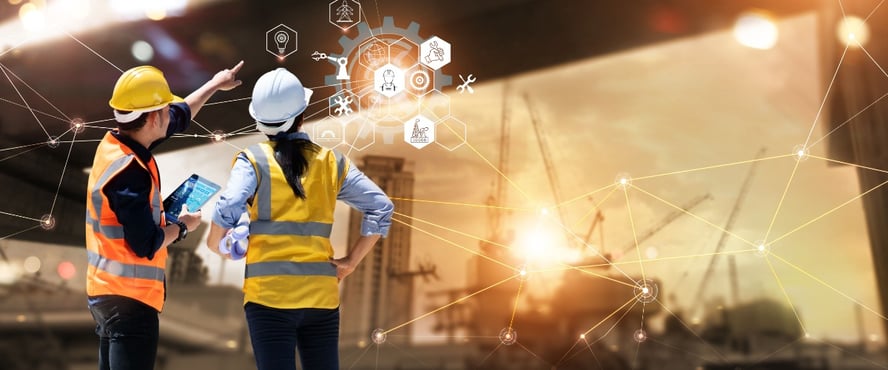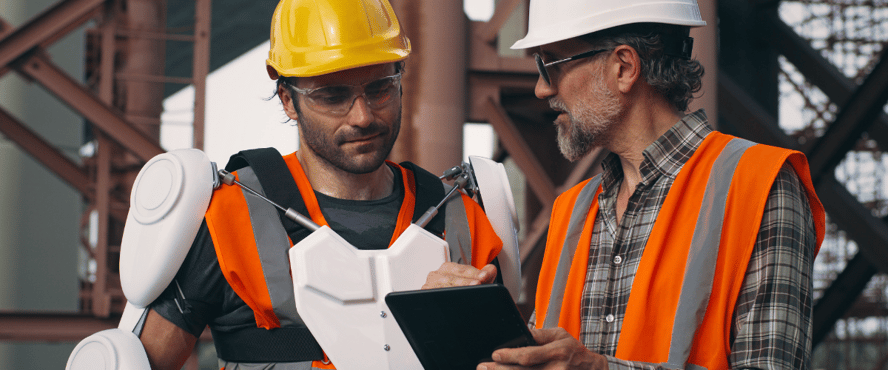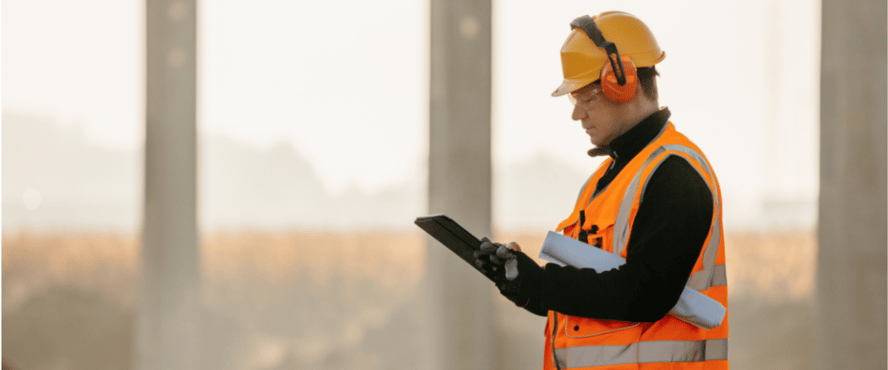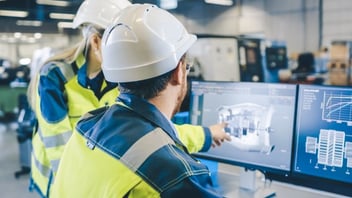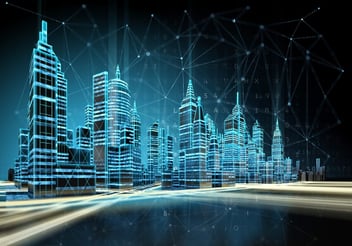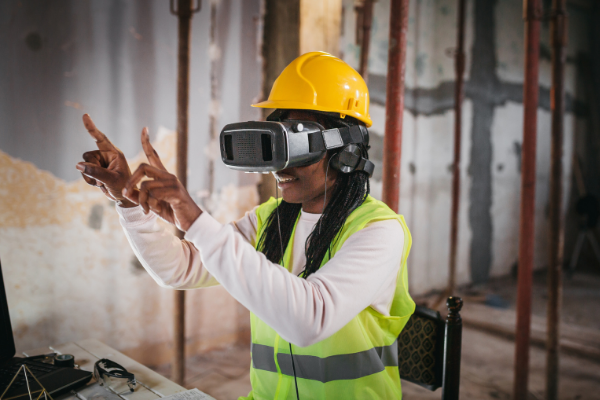
Once disparate, the different segments of the construction industry may finally become more connected through the adoption of certain technologies, including Wi-Fi, mobile phones, IoT, and smart work wear—or wearables.
In fact, wearables are gaining traction in people’s personal and professional lives.
According to Business News Wire: “The global market for Wearable Electronics estimated at $20.8 billion in 2020, is projected to reach a revised size of $90 billion by 2027, growing at a CAGR of 23.3% over the analysis period 2020-2027.”
Wearables include:
- Helmets
- Glasses
- Wrist bands
- Watches
- Clips
- Tags
- Boots
- Exoskeletons
Use Tracking Data to Boost Productivity
While many of these items collect data about the person wearing them, some also collect data about the environment and unique features, such as equipment charging and mixed reality potential.
Data collection can range from location tracking to biometric reading. For example, clips equipped with a unique digital signature (or number) can be distributed to employees at the start of a shift. With IoT, you can always find the clip (and therefore the person wearing it) when you need to contact them if the phone isn’t an option.
Instead of just monitoring location, another benefit is using this data for planning jobsite schedules and layout to increase productivity and safety.
For example, you could track the travel paths of employees (collectively or individually) to determine how much time is wasted when they perform necessary, yet unproductive activities. This could include fetching building materials or tools or finding someone else on-site to relay a message or ask a question.
With travel path data, you can see what happens most frequently. What are those two endpoints? What activity is driving the employees to go from one area to the other? How far apart are they? Can you move them closer together?
Here’s how it could work: by cutting in half a three-minute trip (each way) performed 20 times in a day, you could reduce wasted travel time by one hour a day. And this becomes one more hour of productive labor daily.
Using RFID Tags to Improve Safety
You can improve safety in the field is with RFID (Radio Frequency Identification) tags. Similar to GPS tags, these are localized with a specific function—to alert equipment operators of personnel directly behind their machine.
Workers wear the RFID tags either in their vests or in their helmets. The equipment has a sensor that reads the tags more than 10 feet away. If it picks up a tag while the operator is in reverse, an audio alert activates to let the driver know that one or more people are behind the machine.
The software associated with these wearables allows you to create a “heat map” to show every time the machine’s sensor picked up an RFID tag. Each one of these incidents was a potential accident. Are there any locations where a machine frequently reads tags? Perhaps the jobsite can be re-arranged to decrease the number of unwanted human-machine interactions.
According to the Occupational Safety and Health Administration (OSHA), being struck by an object and/or pinned between objects are two of the “fatal four” in the United States. The others are falling and electrocution. Combined, these contribute to nearly 60% of all deaths in the construction industry.
Biometric Data Can Drive Best Practices
Biometric data, which is data about a person’s body, is a controversial tool because people must give up their personal data—their vital signs. These technologies measure fatigue, stress, signs of COVID or other illnesses, and the presence of drugs and alcohol, among other biometric data. This data can be collected via helmets, arm bands, watches, and boots and then used to make decisions that create a safer work environment.
For example, handheld power tools create a lot of vibration in the arm, leading to HAVS (Hand-Arm Vibration Syndrome). An armband that measures vibrations in the arm can be used to create practices that eliminate less harmful handheld power tool use.
Using Cameras & Smart Goggles to Prevent Errors
Helmet-mounted cameras can collect data (images or video) of a construction site, which can be time- and GPS-stamped. These can be used to compare to the original model or to update a digital twin, as well as in progress reports and in disputes with other parties over as-built completion.
With smart goggles, you can connect people in the field to 3D blueprints. This makes it much easier to correctly build a 3D object using 3D blueprints.
When you build in 3D, you find more design errors at the design stage, whereas projects building from a 2D model tend to find more mistakes at the construction stage. When finding an error at the design stage, very few people need to be made aware and it costs little to change. Plus, these changes can be made swiftly—only the time it takes to enter the changes into the 3D model.
When design flaws are found at the construction stage, more people need to be made aware. Decision-makers will need to be tracked down. Work will be paused so project daily costs (labor, equipment rentals, etc.) will be higher. This means the change takes longer and there’s greater potential for rework.
Overlaying 3D blueprints onto areas of a construction site (mixed reality) through the use of smart goggles is an excellent way to ensure laborers and trades build or install exactly to the design. It’s also an excellent means of inspecting as-built construction. You’ll know there’s an error if the 3D design and as-built item don’t line up perfectly.
Pairing Bone Conduction & Smart Glasses
Communication with people who aren’t on-site is a constant in construction. Due to noise levels, many workers use texting instead of talking. This is fine for quick messages. But some conversations are better spoken.
Headsets featuring bone conduction technology use vibration to conduct sound directly into the inner ear. The wearer will hear the message despite the background noise and even if the wearer is also wearing ear protection.
Amazingly, one manufacturer has paired bone conduction technology with smart glasses capable of taking pictures and video. Find an issue in the field? Use voice command to tell your headset to call someone offsite. Then, use voice command to tell the smart goggles to take photographs or video. You can also use a voice command to share with the person you called.
While this may work best if the two parties are in the same room, this tech allows you to remain immersed enough in the real world that you wouldn’t create greater risks.
Other smart goggles can livestream video shared via Wi-Fi. This, combined with voice communication, is handy for remote troubleshooting and training.
Perhaps the most futuristic wearable are exosuits or exoskeletons—the most body-encompassing wearable.
They don’t currently bring any connectivity features. But it’s not difficult to connect exosuits to GPS devices for location tracking and fall detection. Or to equip them with biometric readers that transmit data to a centralized place so key personnel can make better decisions to promote safety and productivity.
Building a Digital Twin
While you could say wearables are creating a digital twin of their wearers, the data gathered from the tech also feed into the 3D BIM models and digital twins of the asset.
As we’ve seen, wearables generate a mammoth amount of data—from workers' location on the jobsite to potential accidents and drawings vs. actual site comparisons. This data is crucial to forming a digital twin; without it, a digital twin simply cannot be created.
A digital twin combines different technologies, including sensors and Industrial Internet of Things (IoT) data collection tools, and applies advanced analytics and machine learning to gain valuable real-time insights into a physical asset’s progress, performance, and operation.
It integrates data from several sources—including that from workers on-site—to understand the asset better, allowing them to comprehend real-world conditions, such as energy flows, the makeup of materials, and how the asset interacts with its environment and people.
The potential of digital twins is immense. A recent study suggests the digital twin market will be worth $48.2 billion by 2026.
Asite’s mission is to ensure that, as an industry, we can send and receive, capture, share, and collaborate on all the data we are collecting to derive actionable insights to solve global issues.
With the right tools and software, we can deliver on digital twins, remove the data silos plaguing the industry, and begin to enact real change.
Ready to learn more about the powerful potential of data and how you can begin reaping its rewards? Learn more here.
Nathan Medcalf
Nathan Medcalf writes about technology, heavy equipment, and construction for numerous clients and has been published in more than 30 trade publications since 2006.
5 minute read
Asite Insights in your inbox.
Sign up for product news and our latest insights published monthly. It's a newsletter so hot, even global warming can't keep up.
